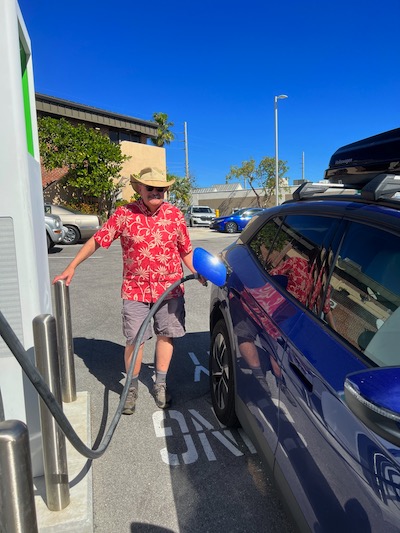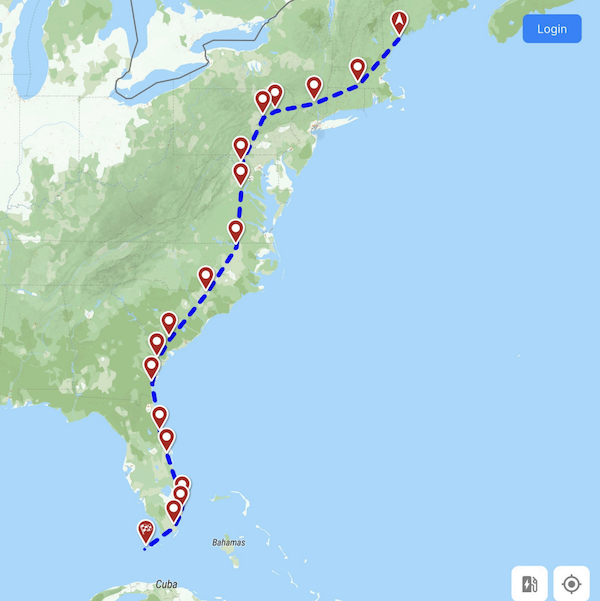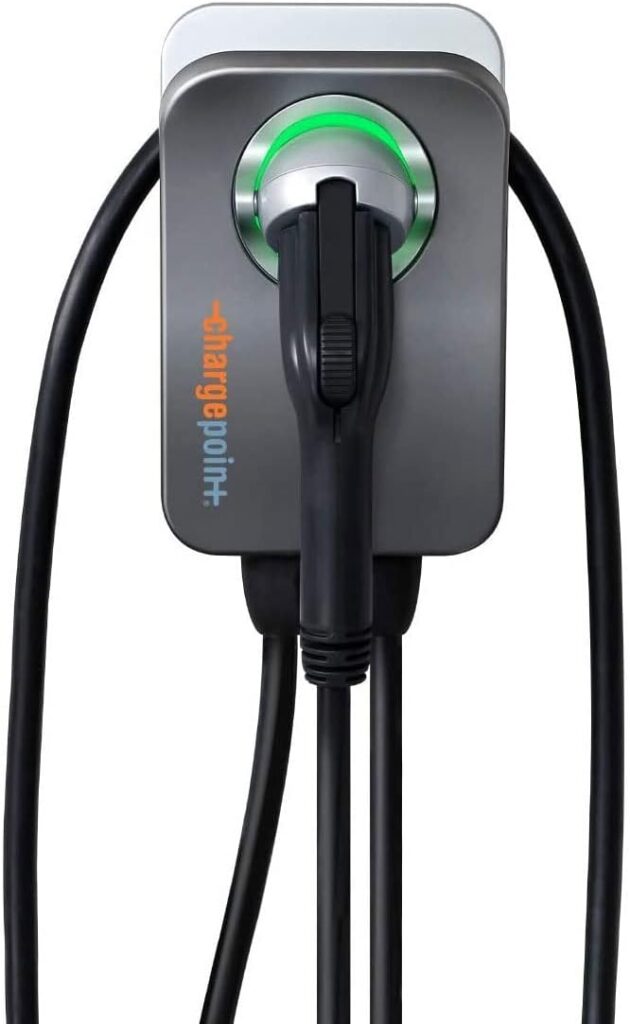eRoadtrip: Snowbird Drives an Electric Car to Florida
Category: Adventurous retirement
Editor’s note: Bill has been kind enough to write for Topretirements on other topics in the past, including the fascinating tale of his “Cleaning Out a Cluttered Victorian”. This installment shares his adventures and lessons learned from driving his new all electric car all the way from Portland, Maine, to Key West, Florida . We think you will find it instructive, particularly if you, like your Editor, are considering buying an electric vehicle!
By Bill Carito
January 15, 2023. This past August, we took a leap of faith in the future and bought an all-electric Volkswagen Id.4 to replace our 2018 VW Tiguan. Why an all-electric? Why not a hybrid? After all, we are a one car family that would not be using this car solely for running errands around town, but also for our 15-18,000 miles per year traveling to see family and for our vacations, including our three-month stay in Key West, Florida.
Frankly? Some of it was about supporting new technology; some of it was a sense of now or never. But, for me, a big incentive was losing the internal combustion engine and all its complications. I’m sure this new tech will have its issues, but I’m going to trust that fewer moving parts means fewer potential mechanical problems.
Trial run
In October we had made a 600-mile trip to Virginia as a trial run, which had prepared us with a few lessons. First lesson: we are no longer going to plan a trip that requires us to travel 600 miles in one day. We are retired, and we don’t have to do that anymore. Fortunately, our Key West trip would occur in chunks of 380-450 miles per day, with a final run of 180 miles down the length of the Keys on January 1.
Day 1, 1800 miles to go – more lessons learned
On December 28, we set out for Key West, a trip we’ve been making for ten years. Our five-day, four-night, 1800+ mile trip would put us in our Key West rental on January 1.


The second lesson was electric car trips require more planning with primary, secondary, and often, tertiary high-speed charging stations along the route identified in advance. I have accounts set up with four charging companies, and between their apps, the PlugShare app, and the occasional hotel with Level 2 charging stations (slower chargers for overnight charging), felt confident about our chances. We were hoping to go 160-180 miles per charge, leaving ourselves about a 20% battery charge as a cushion against unexpected events like heavy traffic.

Better safe than sorry!
Our planning really worked well on the first day of our trip from Portland to
Wilkes-Barre, Pennsylvania. We set out at 7 a.m. and first charged in Sturbridge, Massachusetts around 9:30 where there’s a Panera Bread to sit and get coffee while we waited the 45-60 minutes it usually takes to get a full charge. Then we charged a second time in Newburgh, New York while we ate lunch. This run of 140 miles was a little shorter than we preferred, but we couldn’t identify a high-speed charger between Newburgh and Wilkes-Barre that we felt comfortable reaching. Better safe than sorry; take power where it’s offered. We arrived around 5:30 at our hotel which had two Level 2 chargers which could charge us up overnight.
This is where we learned a third lesson, the reliability of the charging system. At other times, we’d had slow chargers, broken chargers, even charging stations we couldn’t find, but usually the support people could help us work through to get the charge we needed. For whatever reason, this hotel had chosen a charger station run by an independent operator rather than one of the larger companies. A phone call to tech support to deal with an initial charging problem went to an answering machine instead of a live person.
Fortunately, I was able to start charging when we retuned from dinner, but when
I woke up at 1:30 a.m., I looked at the app on my phone to discover charging had
stopped after a gain of only 10% in battery power. I dressed and got the charging
started again. After my battery power increased by another 20%, I thought I could
safely go back to sleep. Wrong. I awoke in the morning to find charging had stopped
again shortly thereafter.
Which charging network to use
We set out in the morning with only a 61% charged battery and had a decision
to make. At this point we decided to rely on the Electrify America network membership
that came with our Id.4. We chose to go to the nearest charging station in Bloomsburg,
PA. It wasn’t ideal because it was a little out of the way west, but still heading south.
After charges in Frederick, Maryland and Stafford, VA, we coasted into our hotel in
Roanoke Rapids, North Carolina. Here, we found a ChargePoint Level 2 station that
provided a 100% charge overnight.
Working with the Electrify America network proved to be reliable for the
remainder of our trip. We readily found most of the chargers we needed through their
app, although one we found by doing a map search, instead. Tech support said they
were adding chargers so fast that they were taking time to get them all into the app.
Another tech support person gave us a tip about signing in and out of the app before
attempting to charge to reset the app and get a real time update on the charging data.
Improved our connections after that with our further technical problems.
And we keep learning
Since we arrived, we learned about a map app, A Better Route Planner, which
we will try for the drive home in April. We are still considering extending the trip to
shorten our days; after all, we are retired and not on a tight schedule. In any event, with
planning, flexibility, and patience, long distance electric car rides are here today. It’s
only going to get better with the massive investments in charging stations and the
continuing improvements in battery technology.
If you are interested in a home charger for your electric vehicle the New York Times rated the Grizzl-E Level 2 charger at the top in its testing.
See the update on the return trip.
Thanks Bill!
About Bill Carito: Bill is an avid Iphone photographer and retired political consultant. Check out his photos at BillCaritophotography.com, many of which have won awards.
Comments? Have you purchased an electric vehicle or are you considering one? Please share your experiences and/or concerns in the Comments section below.






Comments on "eRoadtrip: Snowbird Drives an Electric Car to Florida"
Mick Langan says:
Thanks for the input! Sounds like I won't be getting an electric any time soon...don't want to be that constrained.
LS says:
I seriously considered the Kia EV6 last summer but the dealers where I live were adding at least a $10000 markup and I wasn't going to go along with price gouging. I elected to forgo full electric for now and purchased a Lincoln Corsair plug-in hybrid. It gets me around town on pure electric and very good gas mileage on our frequent road trips. I'll continue to monitor new EVs and wait for the prices to come down on the longer range models.
Jennifer says:
Thanks for the advice. I've had my EV for a little less than a year and have yet to do anything that requires mid-trip charging so I need all the pointers I can get since I plan to retire soon and hit the road!
Admin says:
Kudos to Bill for taking on this environmentally friendly adventure! Our next (2nd) car is going to be all electric, because we drive less than 2,000 miles a year in it and almost all of that is local. Charging shouldn't be an issue. We use our other car to drive to FL every year, and it is currently a gasoline only model. My thinking is we will replace it with a hybrid in the next few years. That way most of our local driving will be electric and when we go on a long trip, we can go long distances between gas fillups.
Ron says:
EVs make great sense especially if you drive less than 200 miles per day
Bill Carito says:
A quick update on cost of travel.
Just got in the last of the charges for our trip down. Less than $50.00. Total.
This includes our savings from using the Electrify America. Network most of the way down. We get 30 minutes of free charging for three years for purchasing our Id.4.
We also received free charging on the chargepoint network when charging overnight at the Hilton Garden Inn in Roanoke Rapids, VA.
Editor's comment: Thanks for the update Bill. Not much in fuel to go a long way!
UncleAL says:
...thanks for the input Bill....I am 70 years young...I will keep my rip-snorting 485 HP Dodge
Challenger, thank you. Living in NY, with the very high electric rates (thank you LIPA), gasoline
is cheaper for me...and much cheaper to insure than an electric car.
LS says:
Many utilities have less expensive rates for charging at night after peak hours. You have to consider total costs of ownership not just the cost of gas or electricity. Yes electric cars are more expensive to insure at present. That is primarily due to the cost of batteries which are declining over time.
There are many other factors that may tip the overall cost of ownership in favor of electrics. Electric vehicles are much simpler mechanically. They do not have as many maintenance items like oil and filter changes, spark plugs, engine air filters, mufflers, engine coolant, transmission fluid (most don't even have transmissions). The time you spend not having your car serviced is another bonus.
Then there are the environmental considerations that heavily favor electrics. They do not emit any fumes or pollutants into the air and are so silent that electrics have a required noise maker at low speeds to warn pedestrians. On the other hand, electrics are heavier and the larger ones can increase wear on tires and on the road surfaces.
As for horsepower, if you ever sit next to a Tesla at a stoplight, you know that they accelerate like a bat out of hell.
John Hutchins says:
The environmental concerns are for the mining of the battery components. I have read that the carbon footprint is greater for an electric vehicle is greater than for traditional vehicles.
Editor Comment: Thanks for contributing John. I have heard the same thing from other folks. But in actuality it seems like electric cars are friendlier to the planet when it comes to carbon emissions over the car's lifetime. Here is a page at the EPA that goes over various points, including battery production. https://www.epa.gov/greenvehicles/electric-vehicle-myths
UncleAL says:
Another HIGH cost of ownership for EVs : It's not like people aren't paying to protect their Teslas. In late 2022, Nerdwallet reported that the average Tesla owner with a good driving history and good credit could expect to pay about $2040 a year for a Model Y and as much as $3044 for a Model X. The average cost to insure a Model 3 is almost 30 percent higher than the national average for car insurance, Nerdwallet said.
While these EVs originally cost between around $60,000 and $80,000, high repair costs will keep them off the road in the future, despite their low odometer readings. A $61,000 2022 Model Y Long Range EV, for example, was in a front collision and would have cost more than $50,000 to fix had the insurer approved the repair....any other vehicle would have less than $10,000 for similar repair. Between HIGH insurance rates, problems with driving range, problems of winter driving (low range rates) HIGH initial cost factors, and lack of charging stations, I would gladly keep my Challenger for another ten years or so (with a smile on my face, of course !) .
Bill Carito says:
Curious about this supposed higher cost of insuring ed’s. Not my experience. only had a modest hike consistent with owning a newer model car.
Admin says:
Good question Bill. Looked around and found various reports, all agreeing that electric cars are a bit more expensive to insure. The common thread is that due to their complexity, they are harder to repair. Some sources say premiums are 15-20% higher. The cheapest electric to insure is the Honda Kona at $2152/year, one of the most expensive is the Tesla Model Y at $3215.
See https://www.progressive.com/answers/car-insurance-electric-vehicles/
BTW, just ordered the e Mustang online yesterday. Not sure when I will take delivery.
Bren says:
The WSJ had an article on a road trip with an EV also, and it was quite the nightmare. Road grades, temps, wind, weight, traffic congestion and more all are more critical in planning a trip compared to driving a gas-powered car. Then there's the news that insurance companies have been writing off EVs in accidents because of the very high cost to repair them. And an EV may be more damaging to the environment in the long run: the batteries become a hazard for disposal; mining the minerals for the lithium batteries in other countries are creating toxic waste pools and denuded landscapes. Taxing EVs to help repair the toxic impact to the environment may be being considered. The brownouts in CA and the major loss of electricity in Buffalo during winter should wake people up to the fact, too, that the country's electric infrastructure is barely adequate for the load it now carries. The push for EVs is more politically driven than scientifically supported.